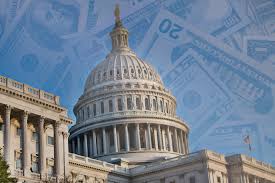
The Fiscal Responsibility Act that finally resolved the debt ceiling standoff might have solved a crisis in the short term — but it sets up a momentous challenge for whoever is elected president in 2024. The Act suspends the ceiling until January 2, 2025, at which time the new ceiling becomes whatever is the then-outstanding amount of national debt.
That means we will hit the new ceiling on the very day it is established. And whoever is elected president next year will start his term in the middle of a new debt crisis. Just two years after hitting the “old” ceiling last January, we will be right back into another standoff.
The only upside is that the new law could set the terms of debate in the 2024 presidential and congressional elections. It could force the presidential — and, for that matter, congressional — candidates to address what they will do on Inauguration Day in 2025, when the nation will be 18 days into a new suspension of borrowing.
The new ceiling is likely to be about $35.4 trillion, after a staggering $4 trillion of borrowing on top of the old debt ceiling of $31.4 trillion. The likely federal deficit — and borrowing — for this fiscal year ending September 30 is about $2 trillion, after having reached a $1.1 trillion deficit at mid-year, according to the March Monthly Treasury Statement.
We had borrowed $535 billion this fiscal year before hitting the old ceiling in January, leaving $1.5 trillion yet to be borrowed by fiscal yearend. Add to that another $2.5 trillion of debt over the following 15 months through December 2024, and we’re at $35.4 trillion. We are already well on the way, having borrowed $704 billion in less than three weeks since enactment of the FRA.
While the Congressional Budget Office projects just a $1.5 trillion deficit this year, it has not adjusted for weak April tax receipts that were “$275 billion less than the CBO anticipated,” nor has it adjusted for significantly higher interest on the national debt. These are no small matter.
As for the Fiscal Responsibility Act, it barely amounts to a speed bump in face of that torrid pace of deficit spending and borrowing. The CBO has scored the FRA as saving only $150 billion annually over a decade. That’s petty cash. Baby steps, even if the steps are theoretically in the right direction.
The FRA mandates that Congress follow the regular appropriation process (passage of 12 separate appropriation bills developed by committees rather one massive “omnibus” bill) or a penalty of a 1% across-the-board cut in discretionary spending is imposed. Even if regular process is followed, significant cuts are unlikely, since Democrats will resist any greater than 1%, preferring the penalty instead.
The FRA limits deficit spending, but it doesn’t reduce it, not after Mr. Biden and the Democrats fought to protect their wild spending. They don’t understand — or are willfully ignorant of the fact — that deficit spending on the scale currently prevailing will not fund more progressive programs.
Rather deficit spending will lead to the elimination of progressive priorities, as interest on the national debt squeezes them out. Net interest on the national debt is the fastest growing item in the federal budget. Soon, it will be the largest item, surpassing Social Security.
In fiscal 2021, net interest was $352 billion; in fiscal 2022, $475 billion. In fiscal 2023, it has already reached an annualized pace of $680 billion over the last three months, per Monthly Treasury Statements. Net interest is not even close to its near-term peak.
Most of the Federal Reserve’s interest rate hikes have been in effect for less than a year. The embedded interest on our currently outstanding $24.6 trillion of publicly held debt ($31.4 trillion less $6.8 trillion in government trust accounts) is about 2.8 percent ($680 billion divided by $24.6 trillion).
That is far below current interest rates of 5.25 percent on short-term Treasury bills and about 3.9 percent on long-term Treasury bonds. Adding another $4 trillion of debt, brings publicly held debt to about $28.6 trillion on January 2, 2025 (just 19 months from now), more than the CBO’s projected GDP.
If the embedded interest rate on that $28.6 trillion of debt has risen to just 3.5 percent — still well below current interest rates, the annualized interest cost will be about $1.0 trillion. The CBO, in contrast, projects an average embedded interest rate of only 2.9% and only $745 billion of interest cost for fiscal 2024.
The increase in interest cost to between $745 billion to $1 trillion will have to be taken from other spending categories every year, or the new debt ceiling will have to be raised by yet another enormous amount in less than two years. Thus, the debate in the autumn of 2024. Which brings us back to Congress.
Speaker McCarthy is to be commended for steering the passage of FRA, including engineering its passage overwhelmingly on Democrat votes. This positions Democrats as supporting only baby steps in restraining the runaway deficit spending that is fueling massive increases in debt and skyrocketing interest costs.
And, of course, inflation. So now Republicans have an opportunity to lead a great national debate about the nation’s unsustainable fiscal path and convince the nation to take the giant steps that are needed.
![]()
Red Jahncke is a nationally recognized columnist, who writes about politics and policy. His columns appear in numerous national publications, such as The Wall Street Journal, Bloomberg, USA Today, The Hill, Issues & Insights and National Review as well as many Connecticut newspapers.






